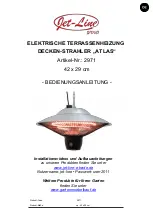
22
www.hotwater .com
100304526_2000545240 _Rev. 01
Make sure the gas supplied is the same type listed on the
model rating plate. The inlet gas pressure must not exceed
14” w.c. for natural gas and propane gas. The minimum
inlet gas pressure shown on the rating plate is that which
will permit firing at rated input.
All gas piping must comply with local codes and ordinances
or with the
“National Fuel Gas Code”, ANSI Z223.1/
NFPA 54
. Copper or brass tubing and fittings (except tin
lined copper tubing) should not be used.
If the gas control valve/thermostat is subjected to
pressures exceeding 1/2 psi, the damage to the gas
control valve/thermostat could result in a fire or explosion
from leaking gas.
If the main gas line shut-off serving all gas appliances is
used, also turn “OFF” the gas at each appliance. Leave
all gas appliances shut “OFF” until the water heater
installation is complete.
A gas line of sufficient size must be run to the water heater.
Consult the current edition of
“National Fuel Gas Code”,
ANSI Z223.1/NFPA 54
and your gas supplier concerning
pipe size.
There must be:
•
A readily accessible manual shut-off valve in the gas
supply line serving the water heater, and
•
A sediment trap ahead of gas control valve/thermostat
to help prevent dirt and foreign materials from entering
the gas control valve/thermostat.
•
A flexible gas connector or a ground joint union between
the shut-off valve and gas control valve/thermostat to
permit servicing of the unit.
Be sure to check all the gas piping for leaks before lighting
the water heater. Use a soapy water solution, not a match
or open flame. Repair and retest as required. When
finished, rinse off soapy solution and wipe dry.
•
Use joint compound or tape
compatible with natural gas
and propane.
•
Leak test before operating
heater.
•
Disconnect gas piping and
shut-off valve before pressure
testing system.
Fire and Explosion Hazard
WARNING
Use pipe joint compound or Teflon
®
tape marked as being
resistant to the action of gases.
The appliance and its gas connection must be leak tested
before placing the appliance in operation.
The appliance and its individual shut-off valve should be
disconnected from the gas supply piping system during
any pressure testing of that system at test pressures in
excess of 1/2 psi. It should be isolated from the gas supply
piping system by closing its individual manual shut-off
valve during any pressure testing of the gas supply piping
system at test pressures equal to or less than 1/2 psi.
Connecting gas piping to the gas control valve/thermostat
of water heater can be accomplished by either of two
methods shown in Figure 18 and Figure 19.
FLEX PIPE
(PROPERLY SIZED
FOR THE HEATER
INPUT RATE)
SEDIMENT
TRAP
GAS
CONTROL
VALVE
GROUND
JOINT
UNION
(OPTIONAL)
CAP
3”
MIN.
Figure 18.
BLACK PIPE
SEDIMENT
TRAP
GAS
CONTROL
VALVE
GROUND
JOINT
UNION
(OPTIONAL)
CAP
3” MIN.
Figure 19.
Teflon
®
is a registered trademark of E.I. Du Pont De
Nemours and Company.
SEDIMENT TRAPS
•
Contaminants in gas lines can
cause fire or explosion.
•
Clean all gas piping before
installation.
•
Install sediment trap in accor-
dance with NFPA 54.
Fire and Explosion Hazard
WARNING
A sediment trap should be installed as close to the inlet of
the water heater as practical at the time of water heater
installation. The sediment trap should be either a tee fitting
with a capped nipple in the bottom outlet or other device
recognized as an effective sediment trap. If a tee fitting is
used, it should be installed in conformance with one of the
methods of installation shown in Figure 18 and Figure 19.
















































